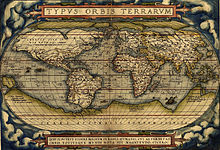
Back ثورة كمية Arabic क्वांटिटेटिव रिवोल्यूशन Bihari Revolució quantitativa Catalan Quantitative Revolution German انقلاب کمی Persian Révolution quantitative en géographie French המהפכה הכמותית (גאוגרפיה) HE Kvantitativna revolucija Croatian 計量革命 Japanese Geografia quantitativa Portuguese
| History of geography |
|---|
 |
The quantitative revolution (QR)[a] was a paradigm shift that sought to develop a more rigorous and systematic methodology for the discipline of geography. It came as a response to the inadequacy of regional geography to explain general spatial dynamics. The main claim for the quantitative revolution is that it led to a shift from a descriptive (idiographic) geography to an empirical law-making (nomothetic) geography.[1][2] The quantitative revolution occurred during the 1950s and 1960s and marked a rapid change in the method behind geographical research, from regional geography into a spatial science.[3][4]
In the history of geography, the quantitative revolution was one of the four major turning points of modern geography – the other three being environmental determinism, regional geography and critical geography. It contributed to the technical geography branch of the discipline, culminating in the emergence of quantitative geography, which includes geographic information science, geoinformatics, and spatial analysis.[5][6]
The quantitative revolution had occurred earlier in economics and psychology and contemporaneously in political science and other social sciences and to a lesser extent in history.
Cite error: There are <ref group=lower-alpha> tags or {{efn}} templates on this page, but the references will not show without a {{reflist|group=lower-alpha}} template or {{notelist}} template (see the help page).
- ^ DeLyser, Dydia; Herbert, Steve; Aitken, Stuart; Crang, Mike; McDowell, Linda (November 2009). The SAGE Handbook of Qualitative Geography (1 ed.). SAGE Publications. ISBN 9781412919913. Retrieved 27 April 2023.
- ^ Yano, Keiji (2001). "GIS and quantitative geography". GeoJournal. 52 (3): 173–180. doi:10.1023/A:1014252827646. S2CID 126943446.
- ^ "The 'Quantitative Revolution': hard science or "inconsequential claptrap"?". University of Aberdeen. GG3012(NS) Lecture 4. 2011. Archived from the original on 24 February 2015. Retrieved 4 February 2023.
- ^ Gregory, Derek; Johnston, Ron; Pratt, Geraldine; Watts, Michael J.; Whatmore, Sarah (2009). The Dictionary of Human Geography (5th ed.). US & UK: Wiley-Blackwell. pp. 611–12.
- ^ Fotheringham, A. Stewart; Brunsdon, Chris; Charlton, Martin (2000). Quantitative Geography: Perspectives on Spatial Data Analysis. Sage Publications Ltd. ISBN 978-0-7619-5948-9.
- ^ Murakami, Daisuke; Yamagata, Yoshiki (2020). "Spatial Analysis Using Big Data: Chapter Six - Models in quantitative geography". Methods and Urban Applications: 159–178. doi:10.1016/B978-0-12-813127-5.00006-0. S2CID 213700891. Retrieved 3 February 2023.
© MMXXIII Rich X Search. We shall prevail. All rights reserved. Rich X Search